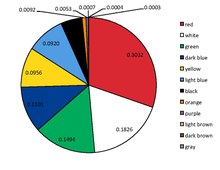All national flags are rectangular, except for the flag of Nepal. The ratios of height to width vary among national flags, but none is taller than it is wide, again except for the flag of Nepal. The flags of Switzerland and the Vatican City are the only national flags which are exact squares.
The obverse and reverse of all national flags are either identical or mirrored, except for the flag of Paraguay and the partially recognized Sahrawi Arab Democratic Republic. See Flags whose reverse differs from the obverse for a list of exceptions including non-national flags.
As of 2011, all national flags consist of at least two different colours. In many cases, the different colours are presented in either horizontal or vertical bands. It is particularly common for colours to be presented in bands of three.
It is common for many flags to feature national symbols, such as coats of arms. National patterns are present in some flags. Variations in design within a national flag can be common in the flag's upper left quarter, or canton.
Colours
-
Main articles: List of flags by color and List of flags by color combination
Distribution of colours in national flags

No comments:
Post a Comment